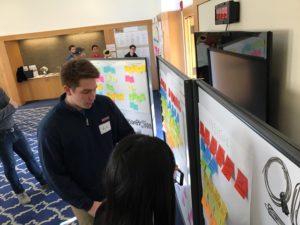Getting to discuss the ethnographic research with our client, Pat Karen, helped clear several things up looking forward. First, he highlighted that we did not have a diverse enough population of interviewees. Our group did not include research on several races or socioeconomic statuses, which is a problem going forward. Our product may have to be tailored to the wealthier user, since most of our data is on upper class white men. Second, we need to find a way to incorporate the internet of things into the product. The product will be technologically advanced, and there are two categories we need to pick between: preventative and surveillance. That is, the technology should be used either to prevent the user from leaving their home or to survey or watch the user and help them in that manner. Last, the product needs to be simple, personalized, and engaging. Our research showed that retirees are resistant to technology and commands from younger people. By making the product personalized and simple, retirees should be able to engage with and enjoy the product. We also spoke briefly with the former Stanford design graduate. He provided some helpful tips on future ethnographic research, such as focusing questions around extremes. He also pointed out that observations of needs should be phrased in terms of verbs, while the solution should show up as a noun.
Key Takeaways:
- The research we gathered was helpful and a great starting point, but we need to use more diverse populations and ask questions using extremes.
- The product must center around the internet of things. Since our research shows that older retirees are more resistant to technology, our user should be new retirees (around 65 years old).
- The product must be simple, personalized, and engaging. Users want to do retirement their way, so the product should be simple enough to customize, use, and engage with.
